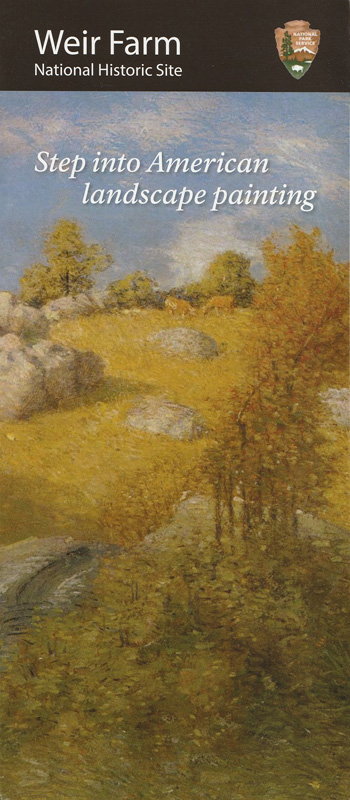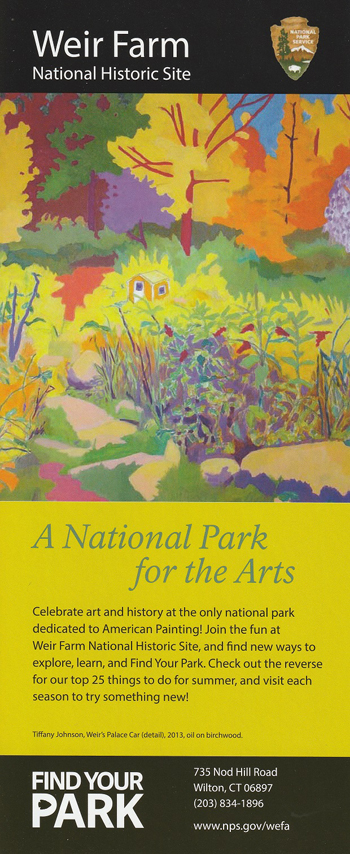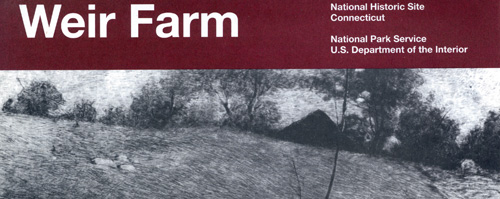|
Weir Farm National Historical Park Connecticut |
 |
 NPS photo | |
American Impressionism—Home is the Starting Place
American Impressionist Julian Alden Weir acquired the 153-acre Branchville, Connecticut, farm in 1882. "Home is the starting place," Weir said, and for nearly 40 years he made this "quiet plain little house among the rocks" his main summer home. He built a studio, twice enlarged the house, added a pond, and acquired more land, bringing the total to 238 acres. The farm inspired subject matter for Weir and his friends Childe Hassam, John Twachtman, and Albert Pinkham Ryder.
From Portraits to Impressionism
In 1877 Weir returned to the United States after studying five years at the École des Beaux-Arts in Paris. While in Paris he visited an exhibition of the new French Impressionists and criticized their sketchy and brightly colored style.
Weir began his career in New York as an art instructor and painter of portraits and still lifes. With his marriage to Anna Baker in 1883, summers at Branchville, and the birth of their first child, he turned increasingly to domestic scenes.
After 1890 Weir began painting more and more out of doors in an Impressionist style. He did not paint with the intense broken colors that he saw in Paris but instead used subtle harmonies of color. Weir painted scenes of his family and nature in soft blues, greens, and silvery grays that evoked a feeling of security and permanence. His conversion to Impressionism was influenced by the beauty of his farm and by discussions and painting outings with Twachtman. In 1897 Weir, Twachtman, and Hassam founded the influential Ten American Painters. Their landscapes and those of others in The Ten are among the finest works of American Impressionism.
J. Alden Weir died on December 8, 1919. He was honored as a gifted painter, teacher, leader, and cherished friend who helped bring artists and American Impressionism into world prominence. His spirit speaks o us still through his art and the landscape of this farm.
A Celebration of Place
Until Weir and other American artists turned to Impressionism, nature's beauty was often depicted as grandiose, with paintings of vast river valleys and western mountains. Impressionism offered a new vision of ourselves and nature. It was the first American art movement to look inward—it examined everyday experiences and appreciated nature found close to home.
Weir and his friends painted the farm's stones, woodlands, meadows, and pond. Weir Farm has been painted by artists ever since. Today about 60 acres remain—the buildings and grounds are largely unchanged. Weir Farm offers the home, studio, and landscape of an artist whose home and land were integral to his artistic vision.
Highlights of J. Alden Weir's Life
1852 Born August 30 at West Point, N.Y., to Robert, Hudson River School painter and drawing professor at the U.S. Military Academy, and wife Susan; christened Julian.
1864-66 Spends time with older brother John Weir, also a painter, at 10th Street Studio Building in New York; first drawings, 1866.
1869-72 Studies painting at the National Academy of Design, New York.
1873-77 Studies in Paris; wins highest award at Jean-Leon Gerome's competition at the École des Beaux-Arts.
1877 In Paris visits third exhibition of French Impressionists; in New York begins career as portrait and still-life painter; elected to Society of American Artists; joins Tile Club.
1878-81 Exhibits at Society of American Artists and American Water Color Society; teaches at Cooper Union, then at the Art Students League, New York, where he remains for 20 years.
1882 Acquires 153-acre farm in Branchville, Conn., from art collector Erwin Davis; elected president of Society of American Artists.
1883 Marries Anna Baker; spends time at New York studio, Branchville farm, and home of Anna's family in Windham, Conn.; work shows new focus: still lifes and portraits are smaller and less formal; paints scenes of Anna and, later, their daughters.
1884 Elected to American Water Color Society; daughter Caroline born March 24.
1885-6 Builds Branchville studio; buys house at 11 East 12th St., N.Y.
1887 Begins printmaking; produces about 140 etchings; son Julian Jr. born in February (dies from diphtheria after first birthday).
1888-9 Exhibits at Society of Painters in Pastel and New York Etching Club; in Paris wins silver medal for painting and bronze for drawings and watercolors.
1890 Daughter Dorothy, future wife of Mahonri Young, born June 18. Weir poses at his studio easel in 1915.
1891 Major solo exhibition in New York launches him as American Impressionist; paints his landscapes in lighter colors.
1892 Daughter Cora born January 29; wife Anna dies February 8; grieving, he avoids the farm; paints a mural 25 feet in diameter for World Columbian Exposition in Chicago.
1893 Exhibits with John Twachtman, Paul Besnard, and Claude Monet at the American Art Association; begins series of lifesized figures posed out of doors; marries Ella Baker (Anna's sister) October 29.
1894-7 Japanese prints increasingly influence his work: compositions feature cropping, asymmetry, and oblique angles; paints The Red Bridge and The Factory Village (both at the Metropolitan Museum of Art, N.Y); uses $2,500 Boston Art Club prize in 1896 to build farm's pond.
1898 Founding member and contributor to the first exhibition of The Ten American Painters; exhibits with group until 1919.
1900-7 Hires architect Charles Platt to expand house and porch and design new entrance; buys land, brings total to 238 acres; wins bronze medal for painting at Universal Exposition in Paris; wins gold medal for paintings and silver medal for engravings at Universal Exposition in St. Louis.
1908-12 Hires architect F. J. Adams to enlarge dining room; moves to 471 Park Avenue, N.Y; suffers from heart trouble; paints in Nassau, Bahamas; exhibition travels to five cities.
1913-18 Travels to England; elected to American Academy of Arts and Letters, president of the National Academy of Design; receives honorary degrees from Yale and Princeton.
1919 Dies in New York on December 8; is buried at Windham, Conn.
The Landscape Beckons
The farm's artistic tradition has continued since J. Alden Weir and other American Impressionists first painted this landscape in the 1880s.
Mahonri and Dorothy Weir Young
Sculptor Mahonri Young and Dorothy Weir were married in 1931. A grandson of Brigham Young, Mahonri (ma HAHN rye) was famous for his small bronzes of athletes and laborers.
At Weir Farm Mahonri Young created his most important public work. He built his studio to complete the commission for the This is the Place monument. Unveiled in 1947, the monument features a 12-foot statue of Brigham Young flanked by his advisors and larger than lifesized figures of trappers and explorers. A frieze depicts the story of the Mormons' move to Utah. Today the monument stands at Emigration Canyon, outside Salt Lake City. His final work, a marble statue of Brigham Young, is in the U.S. Capitol in Washington, D.C.
Dorothy Weir Young, following the tradition of her father and grandfather, worked in oil and watercolor. She took over her father's farm and studio after he died.
Sperry and Doris Andrews
Sperry Andrews knocked on Mahonri Young's door in 1955 because he wanted to meet the noted sculptor. Artists Sperry and Doris Andrews became friends with Young and, when he died in 1957, they bought his farm. The Andrews recognized it as a place of significance to American art and helped preserve its landscape and artistic legacy for future visitors and artists.
Weir at Work
Weir worked in oil, pastel, pen and ink, and watercolor.
All paint, basically, is a powdered pigment blended with a liquid binder to make a smooth paste. Weir mixed pigments (glass jars and black tin) using linseed, poppy, and other oils as binders. With a palette knife (flexible metal spatula in jar) he mixed the paint directly on his palette or prepared it ahead of time, storing it in metal tubes that were easy to carry around the farm. He painted with brushes and painting knives (pointed angular blades in jar) that were ideal for applying paint and creating texture.
Weir also enjoyed printmaking. He used the wood-handled tool to etch his designs into copper plates and the brayer to roll ink onto them. After etching the plate and wiping its surface clean, he used an etching press to transfer the ink that remained in the etched design onto the paper.
Artists at Weir Farm Today
By the 1970s the future of the farm was uncertain because this area was being rapidly developed. In 1990, through a grassroots effort of people who would later form the Weir Farm Trust, Weir Farm was designated a national historic site by the U.S. Congress. Today the National Park Service and the Weir Farm Trust carry on the tradition that J. Alden Weir began more than 100 years ago.
The Trust, a nonprofit organization, offers educational programs, interpretive publications, a lecture series with leading American artists, a Visiting Artists program, and an Artists-in-Residence program. Both the Visiting and Resident Artists programs give artists the opportunity to create work based on their personal experiences or interpretation of the farm. Out of this has come a diversity of expression: paintings, prints, photographs, videos, and sculpture.
The Trust is also collecting art that is important to Weir Farm. Someday these works will be displayed in the park, making it possible for visitors to experience both the landscape and the art it inspired.
About Your Visit
  (click for larger maps) |
Visitor Center Begin your visit at the Burlingham House Visitor Center across the road from the parking area. Here you will find information, interpretive programs, publications, exhibits, a gift shop, and an orientation video. The visitor center is open year-round, but hours vary seasonally; it is closed Thanksgiving, December 25, and January 1. The grounds are open daily from dawn to dusk. Call or check website for information.
Guided Tours The park staff leads scheduled tours of the Weir and Young studios and the grounds. Reservations are required for large groups. Special events are scheduled year-round. Call for tour schedules.
Self-guiding Tours The park offers trails and quiet places to enjoy the beautiful landscape. Ask about the Weir Farm Historic Painting Sites Trail brochure (fee) that discusses the artists and compares their paintings to the scenes today. Other trails lead to the pond, adjacent public lands, and Weir Preserve.
Activities This landscape is as inviting to the artistic spirit today as it was more than a hundred years ago. Bring your paints or your camera and discover your own talents. There are no picnic tables, but you are welcome to picnic on the grass.
Accessibility and Restrooms Facilities and activities at the park are limited for visitors with disabilities. Improvements are made every year. Accessible restrooms are in the Burlingham Barn near the visitor center.
Educational Programs J. Alden Weir encouraged people to learn about art and to find their artistic talents. This tradition continues at the farm today. Weir Farm offers workshops and children's art classes. Artists may apply to the Visiting Artists program. For information about classes and programs contact the Weir Farm Trust or visit the park website.
For a Safe Visit
The Weir house, historic studios, and other historic structures are closed to
the public except on guided tours. Please respect closure signs.
Please be extremely careful if walking on Nod Hill Road; there are no sidewalks, and cars travel fast.
Parking is limited. There is no parking for RVs. Call ahead if planning to arrive with multiple vehicles.
Some trails have uneven footing and exposed tree roots. Be careful when crossing wetland areas on pathway stones. Swimming and wading are not allowed. Fishing is permitted; state regulations apply.
Dogs must be on a leash at all times. Watch for poison ivy and ticks.
Historical and natural features in the park are protected by federal law. Do not damage or remove any stones, plants, or wildlife.
Emergencies: Call 911.
Getting Here Weir Farm is in the towns of Ridgefield and Wilton, Conn. • Vehicle: From I-95 or the Merritt Parkway take U.S. 7 north; go left onto Conn. 102 west; go 0.3 mile; go left onto Old Branchville Road; turn left at first stop sign and go to 735 Nod Hill Road. From I-84: take exit 3 to U.S. 7 south; go right onto Conn. 102 west; go 0.3 mile; go left onto Old Branchville Road; turn at first left and go to 735 Nod Hill Road. • Train: Metro-North to Branchville Station; taxi or walk to the park (about 1.5 miles). Warning: Nod Hill Road is narrow with limited visibility—there is no turnaround for RVs or large vehicles.
Source: NPS Brochure (2004)
|
Establishment
Weir Farm National Historical Park — January 5, 2021 |
For More Information Please Visit The  OFFICIAL NPS WEBSITE |
Brochures ◆ Site Bulletins ◆ Trading Cards

Documents
Alternative Transportation Feasibility Study, Weir Farm National Historic Site (July 1, 2012)
An Inventory of Terrestrial Mammals at National Parks in the Northeast Temperate Network and Sagamore Hill National Historic Site U.S. Geological Survey Scientific Investigations Report 2007-5245 (Andrew T. Gilbert, Allan F. O'Connell, Jr., Elizabeth M. Annand, Neil W. Talancy, John R. Sauer and James D. Nichols, 2008)
Cultural Landscape Report for Weir Farm National Historic Site, Volume 1: Site History and Existing Conditions Olmsted Center for Landscape Preservation Cultural Landscape Publication No. 6 (Child Associates, Inc. and Cynthia Zeitzevsky, 1996)
Cultural Landscape Report for Weir Farm National Historic Site, Volume 2: Analysis and Treatment Olmsted Center for Landscape Preservation (September 1997)
Cultural Landscape Report for Weir Farm National Historic Site, Volume II: Updated Treatment Plan and Record of Treatment Olmsted Center for Landscape Preservation (Timothy W. Layton and H. Eliot Foulds, 2013)
Cultural Landscapes Inventory: Weir Farm (2003)
Foundation Document, Weir Farm National Historic Site, Connecticut (October 2017)
Foundation Document Overview, Weir Farm National Historic Site, Connecticut (January 2017)
General Management Plan/Environmental Impact Statement, Weir Farm National Historic Site (September 1995)
Geologic Resources Inventory Report, Weir Farm National Historic Site NPS Natural Resource Report NPS/NRPC/GRD/NRR-2012/487 (T.L. Thornberry-Ehrlich, January 2012)
Historic Furnishings Report: Weir Farm: Historical Information on the House and Studios and a Furnishing Plan for the Julian A. Weir and Mahonri M. Young Studios, Weir Farm National Historic Site, Wilton, Connecticut (David H. Wallace, 2003)
Historic Furnishings Report Addendum & Implementation Plan: Weir House, Weir Farm National Historic Site (Janice Hodson, November 2009)
Historic Resource Study: An Artist's Retreat: J. Alden Weir's Farm in Connecticut — Weir Farm National Historic Site (Deborah S. Gardner and Christine G. McKay, 2009)
Historic Structures Report: Weir Farm, Weir Farm National Historic Site, Wilton, Connecticut — Volume I: The Site and the Weir Complex Draft (Marie L. Carden, Richard C. Crisson and Maureen K. Phillips, 1995, 1998)
Historic Structures Report: Weir Farm, Weir Farm National Historic Site, Wilton, Connecticut — Volume I: Appendices — The Site and the Weir Complex (Marie L. Carden, Richard C. Crisson and Maureen K. Phillips, 1995, 1998)
Historic Structures Report: Weir Farm, Weir Farm National Historic Site, Wilton, Connecticut — Volume II-A: Weir Farm Outbuildings Draft (Maureen K. Phillips and Marie L. Carden, 1995, 1998)
Historic Structures Report: Weir Farm, Weir Farm National Historic Site, Wilton, Connecticut — Volume II-B: Caretaker's House and Caretaker's Garage (Lance Kasparian and Maureen K. Phillips, 2008)
Historic Structures Report: Weir Farm, Weir Farm National Historic Site, Wilton, Connecticut — Volume III: Burlingham Complex Draft (Maureen K. Phillips, 1995)
Junior Ranger — Letterbox, Weir Farm National Historic Site (Date Unknown; for reference purposes only)
Junior Ranger — Pond Pack, Weir Farm National Historic Site (Date Unknown; for reference purposes only)
Long-Range Interpretive Plan, Weir Farm National Historic Site (January 2013)
National Register of Historic Places Nomination Form
J. Alden Weir Farm (Weir Farm Historic District) (David F. Ransom and John Herzan, January 16, 1983)
Natural Resource Condition Assessment, Weir Farm National Historic Site NPS Natural Resource Report NPS/NETN/NRR-2016/1256 (Geri Tierney and James Gibbs, August 2016)
Newsletter (The Land of Nod/The Sketchbook): Vol. 13 No. 2, July 2006 • Vol. 14 No. 1, Spring 2007 • Vol. 15 No. 1, Winter 2008 • Vol. 16 No. 1, Summer 2009 • Vol. 17 No. 1, Winter 2010 • Vol. 18 No. 1, Summer 2011
Record of Findings: History of Interior Appearances: Weir Studio, Weir Farm National Historic Site (Judith M. Jacob, 2013)
Record of Findings: Investigation of Exterior Finishes: Weir House, Weir Farm National Historic Site (Judith M. Jacob, 2019)
The Weir Farm: Working Agriculture and the Vision of Rural Life in New England, 1860-1940 (Jack Larkin, 1996)
Weir Farm — A Quiet Marriage of Art and Landscape: Summary of General Management Plan (1995)
Weir Farm Suitability/Feasibility Study (February 1990)
Weir Farm National Historic Site
Books

wefa/index.htm
Last Updated: 16-Sep-2024


















